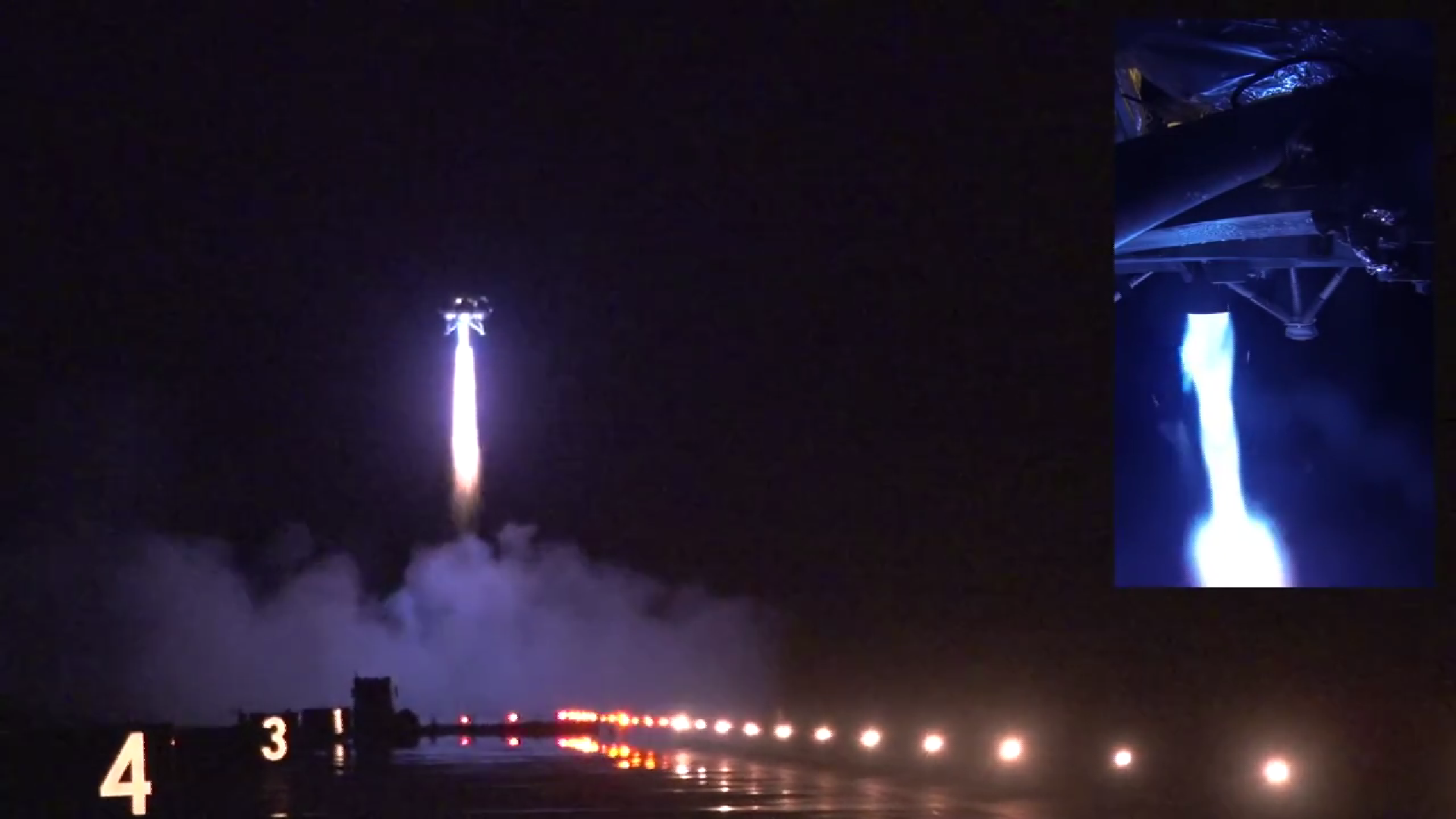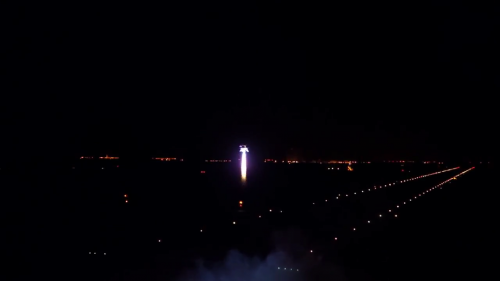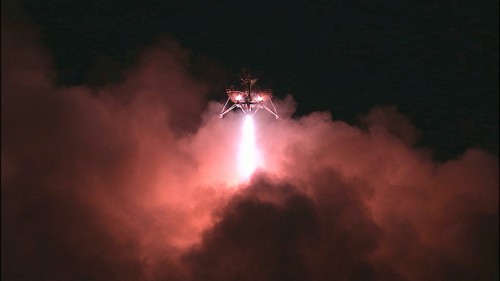
At NASA’s Kennedy Space Center in Florida, at the northern edge of the former space shuttle landing facility, is an area that looks very much like the surface of the Moon, complete with rocks and craters to serve as a site to flight test NASA’s Morpheus prototype planetary lander, and last Wednesday evening (May 28)—after years of work between six of NASA’s 10 centers—Project Morpheus concluded their flight test campaign with the first, and only, night flight test of the program.
“The Morpheus Project has met all of its original objectives and has demonstrated its ability to serve as a reusable flying testbed for advancing multiple technologies in a relevant flight environment,” said Dr. Jon Olansen, the Morpheus project manager at Johnson Space Center (JSC). “I could not be more proud of the team and more ecstatic with the way this test series has gone. We’ve made advances that will be beneficial for human space exploration as well as robotic exploration in the future.”

Morpheus, which has been in development under a strict budget since 2010, is a testbed and technology demonstrator for the development of planetary landers that will, in the future, be capable of accessing hard-to-reach areas on missions to destinations such as the Moon, Mars, or even as asteroid. The vehicle, which some would say resembles a UFO, has conducted many dozens of successful static hot-fire tests and tethered-flight tests at NASA’s Johnson Space Center in Houston, but the vehicle’s development has not come easily. In August 2012, during its second free-flight test at the Kennedy Space Center, Morpheus crash landed moments after lift-off—an accident blamed on a malfunction that resulted in the total loss of the vehicle.
Project Morpheus pressed on to design and build a new upgraded prototype vehicle, utilizing the lessons learned from the crash—despite the fact that the mainstream media was only reporting on the failed outcome. “I am sure some might think of Morpheus as a failure since a significant piece of hardware crashed and burned while under test,” said NASA Administrator Charles Bolden during development of the new prototype following the crash. “Contrary to this view, I regard Morpheus as a success. No one likes to lose equipment, but we recognized that failure as part of the price of learning and acted accordingly.”
In the time since, Morpheus has had one success after another, excelling at exceedingly difficult and higher flights to prove the technology.
“The engineers who conceived of the space shuttle set out to make it a reusable spacecraft. Many rocket engines and spacecraft are single-use. Our little vertical test bed – our lander – is also designed to be reusable. But we don’t have thousands upon thousands of team members or a budget like that – we are a small project with less than 50 people,” said Jenny Devolites, SE&I Lead for Morpheus. “We are a low cost and lean project with an incredibly dedicated and competent team – a team who wants to build rockets and spacecraft and do whatever they can to help further human spaceflight and exploration.”
VIDEO: Project Morpheus Free Flight 14. CREDIT: NASA / Project Morpheus
The Vertical Takeoff / Vertical Landing (VTVL) technology used on Morpheus is not something new, as the Apollo Lunar Modules were the first planetary landers to utilize it. ALHAT, on the other hand, comprises a new set of innovative technologies that would allow a future planetary lander to autonomously identify its landing area by creating 3-D maps of the surface on the fly, while being able to navigate and avoid hazardous terrain and ensuring a safe landing for future cargo and crew missions. The work being done with the Morpheus Lander could lead to the development of planetary landers that would be able to reach many places previously thought as inaccessible, like the Moon’s polar regions or deep craters on Mars. Morpheus’ recent successful flights are a positive sign for a developing capability that could make future missions to those places a reality.
Last Wednesday’s flight test (Free Flight 14) took to the dark Florida skies over KSC at around 10 p.m. EDT to prove the lander’s ALHAT performance in low light. The first launch attempt was aborted due to a non-critical temperature limit exceedance, which was corrected in time to support a successful second attempt.

The flight itself was nearly identical to Free Flight Test-13 (FF13), which was conducted on May 22, but was conducted with a finer-tuned ALHAT based on what was learned in FF13 to navigate Morpheus’ entire approach with ALHAT in closed-loop mode. Morpheus jumped skyward to an altitude of about 800 feet, solely using ALHAT’s Hazard Detection System for guidance, and—assisted by three light detection and ranging (lidar) sensors—the system detected rocks and craters on the ground before performing a safe landing a quarter mile away.
“The flash lidar performed very well, and we could clearly identify rocks as small as one foot (0.3 m) in size from the largest range that Morpheus could give us, which was approximately a quarter mile,” said Eric Roback, ALHAT flash lidar lead engineer at NASA’s Langley Research Center in Hampton, Va. “With this sensor we could even find the safest landing site in a pitch black crater.”
With the successful completion of FF14 the Morpheus flight test campaigns are over, at least for now, but a lot of work still needs to be done.
“A lengthy post-flight analysis will be necessary to fully evaluate Morpheus and ALHAT performance and make the incorporated technologies available for infusion into future missions,” explained Olansen. “We will also work to disseminate lessons learned throughout the project lifecycle. The conclusion of these flight test campaigns will complete the objectives of Morpheus as currently identified. Future operations of Morpheus have not currently been identified, but the system will remain viable.”

Morpheus utilizes other innovative approaches as well, in addition to its advanced autonomous navigation and landing technologies. Its propellant is a mixture of “green,” non-toxic liquid oxygen/liquid methane fuel, which is stored inside the lander’s four spherical propellant tanks. Future missions to the Moon and Mars could potentially produce these elements through in-situ resource utilization, thus largely mitigating the need for carrying all the necessary fuel required from Earth. Though the current Morpheus prototype vehicle is relatively small, having a payload capacity of 500 kg, the Morpheus team hopes to scale it up in the future to accommodate both crew and cargo.
As for future applications of the technology Morpheus has tested, the team offers the following comment:
“The technology is scalable – which means that it could potentially be used on other, larger vehicles – that may or may not be human-rated. The first intent would more than likely be a robotic-type of mission, and depending on the path forward, and vehicles out there to get us beyond Low-Earth Orbit (LEO), the ALHAT technology and other Morpheus technologies could be part of that – at least we HOPE. So basically it’s not really the ‘Lander design’ as the intended tests for us, but rather the technologies we tested on these vehicles. If we were to continue testing, we’d probably use different vehicle designs as well.”
“Once this technology goes into service, the days of having to land 20 or 30 miles (32 to 48 km) from where you really want to land for fear of the hazardous craters and rocks will be over,” added Roback. “Then we can land near the truly interesting science and near the critical resources that will be needed for eventual colonization, and we can do it over and over again safely.”
For now Morpheus will remain at KSC while the team continues to pour over the data to determine whether or not another flight test may be needed. But, if another flight test is not needed (and another flight test is not expected), then Morpheus will go back to Johnson Space Center in Houston and ALHAT will return to NASA Langley.
“The Morpheus team has been working very long and hard hours for nearly 4 years, particularly during the last 6 months where much of the team has spent a lot of time away from home and family,” added Olansen. “At the completion of the test campaigns the team will first celebrate with some time off for most, and then I will create an opportunity where I can thank everyone who has contributed and celebrate what they have achieved on behalf of NASA.”
Want to keep up-to-date with all things space? Be sure to “Like” AmericaSpace on Facebook and follow us on Twitter: @AmericaSpace




Great article. Putting four of these together can make a manned lunar lander at only a few 10’s of millions in development cost.
Bob Clark